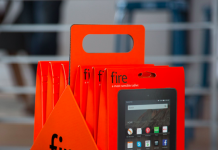 TeleRead reader Felix Torres originally posted this as a comment to my earlier story, but I felt it was so cogent and well-written it deserved promotion to the front page. –CM
TeleRead reader Felix Torres originally posted this as a comment to my earlier story, but I felt it was so cogent and well-written it deserved promotion to the front page. –CM
Yes, Kindle’s new baseline pricing is a serious problem to competitors. But it’s actually bigger than it looks.
Beyond the unreachable advertised prices, an added problem for competitors is that the subsidized Kindles aren’t just flashing ads, but offering up discount coupons. If it were just ads, it would be easy to sign up with Google or Microsoft to feed banner ads to their connected readers. But finding a steady source of discount offers a la Groupon is a far bigger challenge, especially since Groupon itself is currently facing some rough sailing. A good chunk of the KSO deals are actually in-house Amazon discounts so, make no mistake, a good portion of the KSO subsidy is in fact coming from Amazon’s pockets as an investment to grow their new online ads business.
Next, trying to “debunk” the pricing, as some online commenters suggest, is a losing cause.
First, because you can actually buy Kindles at those advertised prices.
Second, because the ads/offers do not show up while reading. And they aren’t particularly intrusive. People who object to the ads are doing so on principle. And they have the option to pay full price.
Third, because the special offers have, so far, offered enough added discounts that a significant portion of buyers prefer the subsidized versions. There is an entire section on Mobileread dedicated to listing past and current offers so its easy to see what kinds of deals you’ll be offered before committing. You can also find testimonials of people who found enough discounts, on things they were going to buy anyway, to effectively get their Kindles free. (Obviously anecdotal but it serves as nice word of mouth promotion.)
More than just a new price model, in moving the goalposts on pricing, Amazon is bringing a different business model to ebook readers; the subsidized hardware model of the gaming console market. A model where content revenue greases the way for consumption hardware. A model that works very well with walled-garden content and not at all with open platforms (remember the ad-subsidized PCs of the last decade?).
This has been a viable option and a possibility ever since the establishment of the Agency Model since it precluded price competition on ebooks and provided a more or less predictable post-sale revenue stream for the walled-garden readers like iBooks, Kindle, and to a lesser degree, Nook and Kobo. Ever since Agency Pricing went into effect, people have been expecting Amazon to do a “free”, subsidized-hardware Kindle play. Well, Special Offers pricing is the way Amazon chose to do it. (Look at the $79 entry level K4; how many of the recurring $20 Gift card for $10 offers will it take to bring the effective cost to zero? A year’s worth?)
That Amazon chose to tie their subsidies to ads and special offers doesn’t necessarily mean that those ads and offers are in fact subsidizing the hardware. On the contrary, it may be that both the hardware and the in-house discount offers are being subsidized by the growth of ebook sales and the Agency model-guaranteed 30% gross. People refuse to accept that Amazon is a company built to thrive at 35% net profit margins. Given an extra 25% to work with, they’re not going to laugh all the way to the bank; they’ll use it to grow new businesses. At the end of the day they have the same take-home net as they would’ve under competitive pricing but they’ve weeded out many (most?) of the hardware-only competitors and ramped up a nice (eventually) profitable new business on the side as the installed base of KSO’s becomes an attractive target for external ads and promos. No need to buy Groupon as Kindle tried to do; at a lower cost they can use Kindle to build their own. (Clever dudes, aren’t they?)
What can competitors do? Very little. They can try to build a co-op special offers service, like some have done to try to compete with Amazon’s Prime. They could try to get Groupon to help them. They could try to get deals with Google or Microsoft. But none of those are likely to provide the revenue needed to match KSO pricing.
The “best” option for competitors is to do nothing.
Because there is nothing meaningful they can do. B&N needs the full ebook revenue to offset their declining brick and mortar losses. Kobo needs it to expand internationally. The others don’t have even that.
Amazon has indeed moved the goalposts. And they’re not coming back.
Ad-supported readers are the new entry level baseline; ad-free is the new “premium” pricing. Anything above that is simply not viable.
Clearly a new phase in ebook evolution highlighting, more than ever, that ebooks are a mass-market content business, not a niche hardware business.
Between KSO pricing, Fire, and the upcoming NC2 and Kobo tablets, I expect another weeding of hardware-only players. iRiver, Pandigital and (alas) Pocketbook are in the crosshairs.































Sony is in the process of releasing its latest ereader, the PRS-T1, which is a touch screen, stylish design, Sony-branded device that is quite a viable option. It also has its own bookstore, can be fed from the Kobo store as well, has international distribution and, finally, a competitive price as well.
Inside the US, Kindle will expand its lead; B&N has some soul searching to do.
Outside the US, Kindle will continue to expand but with less fire-power than an in the US (partly because the product and offers are dramatically less aggressive). There, Kobo and Sony have a good story to tell and, with a lean infrastructure, Kobo may continue to grow strongly.
Kobo is also the only serious competitor to Amazon on the e-book content front, building out in both US and international markets and could quite comfortably morph into a business focused more strongly on content than hardware.
@Mr Inglis: I would suggest that Kindle’s biggest growth in the next two years (2012-13) will be *outside* the US. And european ebook adoption will be the key. Basically I think they will face *less* meaningful opposition overseas than locally. B&N do face some soul searching but they have been giving Amazon a serious challenge and likely will continue to do so even if their new-reader market share likely has peaked.
Elsewhere, things look better for Amazon:
The entry level K4 is already showing up on some international Amazon sites and the (renamed) Keyboard Kindle is everywhere. Even without the lubrication of the special offers, the K4 at US$109 (or equivalent) seriously undercuts most competitors especialy since Amazon doesn’t normally follow tradition and charge significantly more to european customers. Given that Amazon is steadily planting local Kindle stores all over (UK and Germany in place, France next week, Spain and Italy some time after that…) and there is nothing like B&N to mount a broad-based challenge, Amazon will be free to take its time and hit each market in force in order of size and content availability. Its a bit more work to hit 50 small to medium markets than one big one, but with the big one safely in hand the resources to play elsewhere won’t be lacking.
I know Europe is supposed to be epub-phillic territory and the Sony brand still carries clout there but the same was true of the UK before the local Kindle store opened up. With ebook adoption rates under 2% on average I suspect the other 98% of those markets will behave a bit differently than the early adopters. (Otherwise, they too would be early adopters. 😉 ) And the biggest difference is that newcomers will care less than early adopters about specs and standards and way more about content and price.
Now, I do agree that Kobo is following a rational policy in expanding globally and doing so through partnerships, which gives them a good chance to be a solid #2 worldwide eventually, but in doing so they are going to be stressing the much smaller local independents feeding the early adopter’s generic Adept ecosystem who will find themselves caught in a 3-way squeeze between Kobo, Amazon, and Apple. (iBooks is an afterthought in the US, but it covers some 36 countries already, so it’s bound to have some impact, especially since it peddles non-Adept epub.) The problem is that, like B&N, Kobo doesn’t have the resources to hit 50 markets as fast as Amazon can, even with local allies. So Kobo is likely to expand more slowly than Amazon and their gains are more likely to come from consolidating the existing epub camp around the Kobo stores than from the format agnostic bargain hunters more likely to buy into Kindle. Since I don’t think it is wise to bet against “cheaper”, I expect there will be more of the latter than the former. Again, content and price trumps specs and standards.
Simple test:
Both Kobo and Kindle have german ebookstores open and the Kobo reader will hit there in a few weeks. It shouldn’t take more than a few months after that to see how it plays out betwen them.
And then we’ll see how the other 98% behaves.
Who knows? Maybe they’ll just yawn. 🙂
@Mr Torres (such formality!): Actually, the Kobo German stores open on Saturday. 🙂
My understanding is Kobo will be in all the specific markets you cite (UK, Spain, Italy) with branded Kobo online stores within 2011.
Plus Kobo Touch already can be “reskinned” by the end-user in six languages today — everything, all commands, all prompts, work in German, Dutch, etc. It’s trivial to ship in other languages; the bookstore already have content in these languages.
Now, don’t mistake me: Kobo is not a Kindle killer but it at least has the potential to co-exist and behave like a formidable alternative. It’s got a viable, growing bookstore; five million current e-book customers; and momentum.
As long as we measure the market by device sales, Kobo will show up far behind. But Kobo’s platform agnostic strategy is well advanced and accounts for the significant attraction of its content store … which is where the long-term profits will reside.
Kobo will have to be priced aggressively to expand overseas. Currently, the Kobo Touch is selling in the UK for £169.99 ($265) at WH Smith. They need to do better than that. Hopefully, the German price will be considerably less.
I’ve owned a Kindle with Special Offers since May. The ads are not only very easy to ignore but some of the special offers are worthwhile: I’ve purchased several books and MP3 albums for $1 using special offer codes and I’ve gotten at least $20 in gift certificates for buying stuff that I was going to buy anyway.
That’s not a bad price for the Kobo Touch at WHSmith … but the best news is that it’s now for sale in retail in the UK. Until recently, only the Kobo WiFi was available in those stores. If the £170 includes 17% VAT that’s not atrocious. I wonder what the new Sony will be priced at?
Sony PRS-T1 is £129 for pre-order.